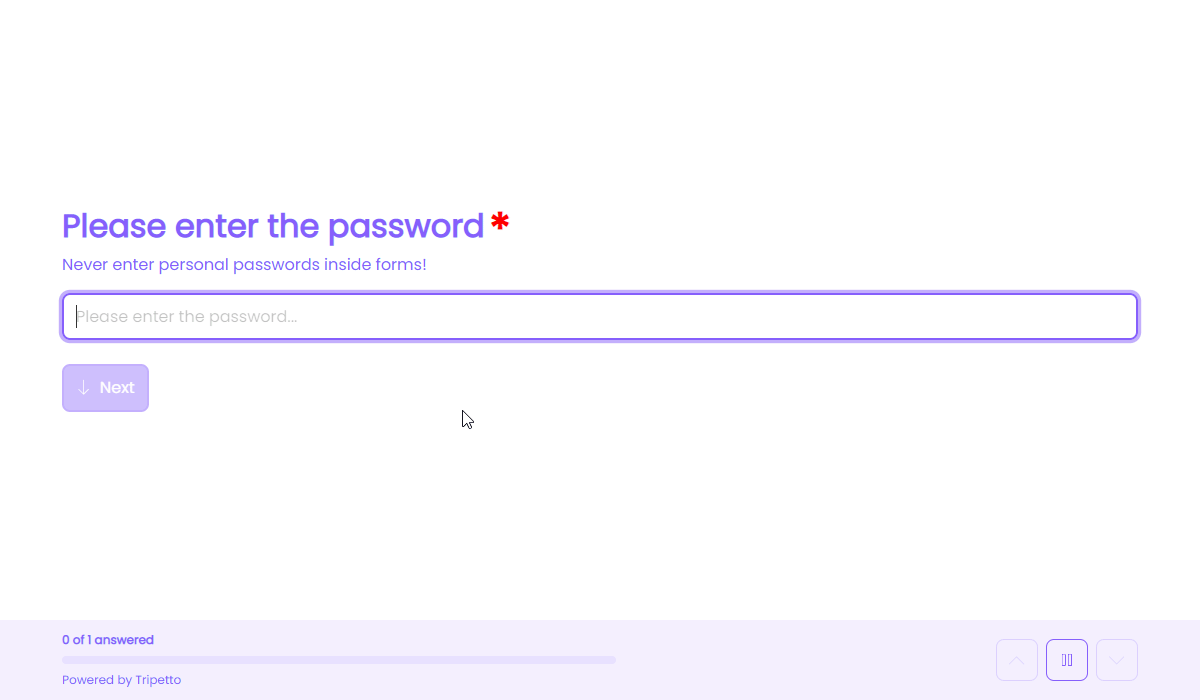How to use the password block
Learn everything you need to know to use the password block in your forms.
When to use
Use the password block to let your respondent enter a value that's not visible in the form. Optionally you can use this block to protect parts of your form.

🚧 Warning: Storing password
By default the password block does not store entered passwords in your form. If you choose to store the passwords nonetheless, please make sure you are always careful with using your dataset, as it contains vulnerable information.
How to use
Add a new block to your form and then select the question type Password. You can now customize this block to your needs with the following features:
General
- Text
Use theTextfeature for the name/title of this block. - Description
Enable theDescriptionfeature to add a description to this block. - Placeholder
Enable thePlaceholderfeature to add a text inside the empty input control of this block. - Help text
Enable theHelp textfeature to add a help text to this block.
Options
- Required
By default this block is not required to fill out by your respondents. Enable theRequiredfeature to make this block required to fill out. - Visibility
By default this block is visible in your form. Enable theVisibilityfeature to hide it for your respondents. - Alias
By default the name/title of this block will be used in your dataset. Enable theAliasfeature to use a different name in your dataset. - Exportability
By default entered values of password blocks aren't saved to the dataset of the form entries. In that way the passwords that your respondents enter, aren't saved unnecessarily.
If you wish to include the entered passwords in your dataset anyway, you can overrule the default setting by enabling theExportabilityfeature and activate theInclude in the datasetsetting. Entered passwords will now be saved and readable inside your dataset. Please make sure you are always careful with using the dataset if you choose to save passwords!
Secure password verification
You can use the password block to protect (parts of) your form by using the secure password match check. More information on that can be found in this article.
Logic
Logic is important to make your forms smart and conversational. The password block can work with the following branch conditions to help you with that:
Block conditions
- Password matches
your password(more information about password verification); - Password does not match
your password(more information about password verification).
Evaluate conditions
- Value matches
your filter; - Value does not match
your filter; - Value contains
your filter; - Value does not contain
your filter; - Value starts with
your filter; - Value ends with
your filter; - Value is empty;
- Value is not empty.
Filters
When we mention your filter above, there are some different filters that you can use to make the right comparison:
- Text - Compare with a fixed text that you enter;
- Value - Compare with another block value entered in the form by a respondent (more info).
Calculations
You can use the calculator block to perform calculations with given answers. The password block supports the following calculation operations:
- Compare - Compare a password and output a value based on the result of the comparison;
- Character count - Count the number of characters in a password;
- Word count - Count the number of words in a password;
- Line count - Count the number of lines in a password;
- Count occurrences - Count the number of occurrences of a certain text, character or regular expression in a password;
- Convert to number - Convert a password to a number value.
